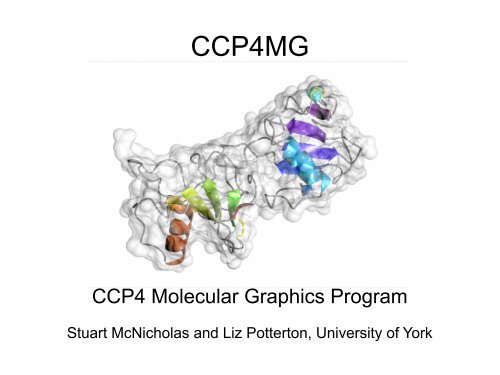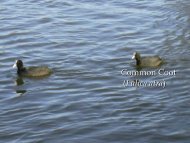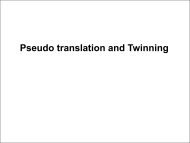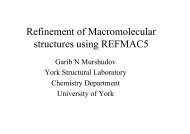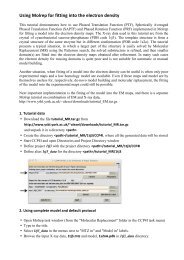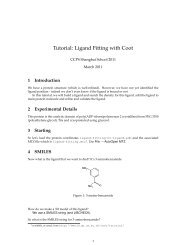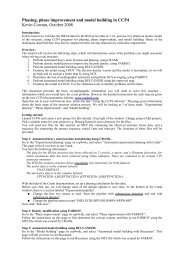Stuart McNicholas: ccp4mg - York Structural Biology Laboratory ...
Stuart McNicholas: ccp4mg - York Structural Biology Laboratory ...
Stuart McNicholas: ccp4mg - York Structural Biology Laboratory ...
You also want an ePaper? Increase the reach of your titles
YUMPU automatically turns print PDFs into web optimized ePapers that Google loves.
CCP4MGCCP4 Molecular Graphics Program<strong>Stuart</strong> <strong>McNicholas</strong> and Liz Potterton, University of <strong>York</strong>
Introduction●●●CCP4MG is a molecular graphics programfunded by CCP4.Its primary focus is the visualization andanalysis of macromolecular structure.It produces high quality rendered images andmovies.●http://www.ysbl.york.ac.uk/~<strong>ccp4mg</strong>/
Displaying Molecules (styles)●CCP4MG can display molecules in manydifferent ways:●●●●●●●Bonds, cylinders, ball and stick, spheresCA tracesThermal ellipsoidsRibbons, worms, etc.Base pair “sticks”, base blocksLipid cartoonsSurfaces
Atom Selections●●CCP4MG can use the various styles/colourswith all atoms in a coordinate file or a subset ofthe atoms.There are quickly accessible menu items forcommon selections, e.g.:●●●●All atomsCA traceMain chain/side chainsAll peptide/nucleic acid/solvent/metals, etc.
Atom Selections●More complicated selections may be madeusing the “Selection browser”:●●●●●●Neighbourhoods of various atomsAtom types, residue typesResidue rangesSecondary structure elementsIndividual atomsLogical and/or/not of all the above
Selection Browser
Selection Browser
Selection Browser
Selection Browser
Selection Browser
Picture Wizard●●●The picture wizard is an automatic way ofgenerating complex scenes with multipleselections, colouring, styles, etc.Representations are organised into various“styles”The picture wizard is shown at the top of the filebrowser window when a coordinate file isloaded, or can be accessed from the displaytable.
Molecular Symmetry●●Symmetry mates of a molecule can bedisplayed using data from pdb file, mtz file or byspecifying by hand.The user may choose:●●●Continuous crystal, symmetry mates generatedwithin certain radius of screen centre.Unit cell, with optional extensions along crystalaxes.Generate specific mates from symmetry operations.
Electron Density●●●●Electron density maps can be read/createdfrom any CCP4 supported file format.Density can be represented as chickenwirelines, chickenwire cylinders, solid surface ordots.By default a 10Å cube of density is drawn, thissize may be changed.The density can be clipped to a set of atoms.
Vectors●●●●“Vectors” can be drawn between pairs of atomsand arbitrary points in 3D space.The vector may be a line, dashed line, cylinder,arrow, etc.Vectors can have text labels.Vectors can be read/saved in cif format.
Geometry●●In “geometry mode” double clicking on atomsallows one to measure distances, angles anddihedral angles.A table displaying this information is displayed.The table is interactive, so that one may deleteatoms from the current selected set.
Other Display Details●●●●All objects●●●May be visible/invisible“Flash”Be transparent with arbitrary opacityOne can have multiple views (e.g. side-by-sidestereo)Depth-cueing fog, clipping, background colourand lighting are all user definableLots of stuff is highly customizable
Images and Text●Text may be added to the scene in multipleways:●●●Annotations to modelsAtom labels and labels creates by clicking on atoms“Legends”. Text objects in 2D window coordinates.●●All text objects can use any systemfont/style/size.Annotations and Legends can display text withmultiple fonts/styles/sizes/colours.
PISAThe EBI website defines PISA:PISA is an interactive tool for the exploration of macromolecular (protein, DNA/RNAand ligand) interfaces, prediction of probable quaternary structures (assemblies),database searches of structurally similar interfaces and assemblies, as well assearches on various assembly and PDB entry parametersE. Krissinel and K. Henrick (2007). Inference of macromolecular assemblies from crystalline state. J.Mol. Biol. 372, 774--797.E. Krissinel and K. Henrick (2005). Detection of Protein Assemblies in Crystals. In: M.R. Bertholdet.al. (Eds.): CompLife 2005, LNBI 3695, pp. 163--174. Springer-Verlag Berlin Heidelberg.E. Krissinel (2009). Crystal contacts as nature's docking solutions. J. Comp. Chem., in press;published on-line 6 May 2009; DOI 10.1002/jcc.21303}
PISA●●PISA identifies the chemical monomers and theinterfaces between the monomers including themonomers generated by applying symmetry tothe input file coordinates.By evaluating the strength of interactionbetween the neighbouring monomers in acrystal, PISA predicts what would be the moststable multimer and therefore the most likelybiological form of the structure.
PISA●●●There is a command line version of PISA towhich CCP4MG has an interface.One can simply ask PISA to analyse astructureInterfaces and assemblies may be visualizedfrom the results.
Structure Superposition●CCP4MG has three methods of structuresuperposition:●●●SSM. This is the default method. It is the simplest touse and usually gives excellent results. The methodattempts to match secondary structure elements indifferent coordinate sets.Close Residues.This method is useful forperforming locally optimised superposition after aglobal superposition by SSMUser-defined. This is the most flexible: the user canspecify in many ways the atoms to superpose.
Movies●●●Movies are creates by defining a series of “keyframes” and then (optionally) interpolatingbetween them.Key frames may also define simpletransformations (rock, roll, etc.)Movies can be created either as animated gifsor as MPEG streams.
Rendering●CCP4MG has two methods of producing finalimages:●●Screenshot. A simple dump of the screen pixels isperformed.Rendering. This uses a Renderman compatiblerenderer “Pixie”. The images are of much higherquality than the simple screen dump. This method ispreferred for publication images. The images maybe rendered at any size and effects such as raytracedshadows and proper transparency arepossible.
Documentation●●●Lots of user documentation is provided with theCCP4MG. The program contains a built inbrowser to view the documentation.The documentation is also available online athttp://www.ysbl.york.ac.uk/~<strong>ccp4mg</strong>/CCP4MG also has help buttons on most GUIsto take the user to the correct position in thedocumentation.
Tutorials●●●http://www.ysbl.york.ac.uk/~<strong>ccp4mg</strong>/<strong>ccp4mg</strong>_help/tutorial/index.htmlOr within program Help->Help and click on “Tutorials” linkCCP4MG comes with tutorial data:●●File->Get tutorial data.Creates a copy in user's home area in directory<strong>ccp4mg</strong>_tutorial.
Acknowledgements●●●●●●●●●Liz PottertonEugene KrissenelKevin CowtanPaul EmsleyMartin NobleJan GruberBernhard LohkampKeith WilsonPhil Evans


